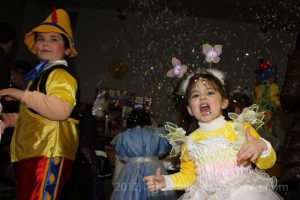 Its funny how we make our traditions but gradually in Barga the traditional feast of Carnivale has evolved into three distinct and separate areas and participants and each with a different feel to the occasion.
Its funny how we make our traditions but gradually in Barga the traditional feast of Carnivale has evolved into three distinct and separate areas and participants and each with a different feel to the occasion.
Yesterday in Barga Giardino it was the turn of the younger kids to dress up and enjoy themselves at the Rio de Jardin (article here) Later on that day, the “big guns” were wheeled out as the grown ups danced the night away under the big tent on Fosso for Il Baccanale (article here) This morning finally the small tots get their chance to strut their stuff at the annual Carnavalino held down at the Oratorio Sacro Cuore.
The Oratorio Sacro Cuore was filled to bursting with children, noise, and confetti as persistent rain meant that playing outside was for only the very hardy or slightly foolish.
Its going to take some time to clear up the Oratorio after all the kids have finally left but according to the organisers of the events, it was all worth it. Another year past and another successful Carnavalino.
no images were found
Carnival is a festive season which occurs immediately before Lent; the main events are usually during February. Carnival typically involves a public celebration or parade combining some elements of a circus, mask and public street party. People often dress up or masquerade during the celebrations, which mark an overturning of daily life.
The Lenten period of the Liturgical year Church calendar, being the six weeks directly before Easter, was marked by fasting and other pious or penitential practices. Traditionally during Lent, no parties or other celebrations were held, and people refrained from eating rich foods, such as meat, dairy, fats and sugar. The forty days of Lent, recalling the Gospel accounts of the forty days that Jesus spent in the wilderness, serve to mark an annual time of turning. In the days before Lent, all rich food and drink had to be disposed of. The consumption of this, in a giant party that involved the whole community, is thought to be the origin of Carnival.
While it forms an integral part of the Christian calendar, particularly in Catholic regions, some carnival traditions may date back to pre-Christian times. The ancient Roman festivals of Saturnalia and Bacchanalia may possibly have been absorbed into the Italian Carnival. The Saturnalia, in turn, may be based on the Greek Dionysia and Oriental festivals. While medieval pageants and festivals such as Corpus Christi were church-sanctioned celebrations, carnival was also a manifestation of medieval folk culture. Many local carnival customs are based on local pre-Christian rituals, for example the elaborate rites involving masked figures in the Swabian-Alemannic carnival.
Some of the best-known traditions, including carnival parades and masquerade ball masquerading, were first recorded in medieval Italy. The carnival of Venice was for a long time the most famous carnival. From Italy, carnival traditions spread to the Catholic nations of Spain, Portugal, and France. From France, they spread to the Rhineland of Germany, and to New France in North America. From Spain and Portugal, they spread with Catholic colonization to the Caribbean and Latin America. -- source